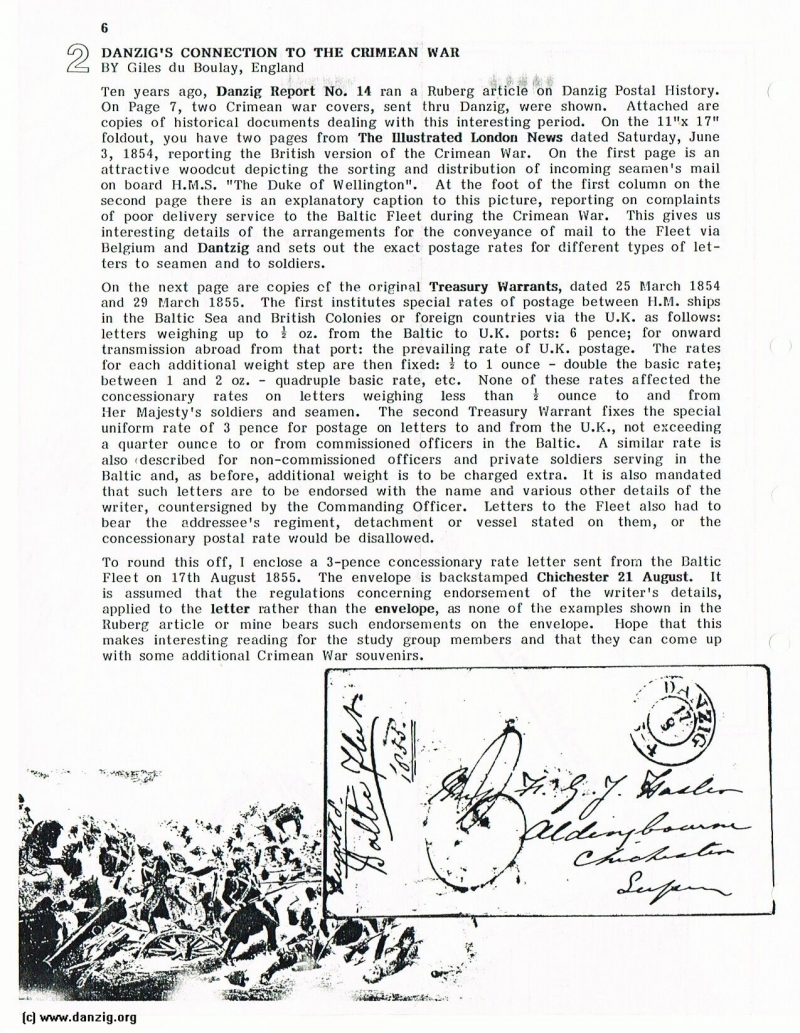
DANZIG’S CONNECTION TO THE CRIMEAN WAR
BY Giles du Boulay, England
Ten years ago, Danzig Report No. 14 ran a Ruberg article on Danzig Postal History. On Page 7, two Crimean war covers, sent thru Danzig, were shown. Attached are copies of historical documents dealing with this interesting period. On the 11”x 17” foldout, you have two pages from The illustrated London News dated Saturday, June 3, 1854, reporting the British version of the Crimean War. On the first page is an attractive woodcut depicting the sorting and distribution of incoming seamen’s mail on board li.M.S. “The Duke of Wellington”. At the foot of the first column on the second page there is an explanatory caption to this picture, reporting on complaints of poor delivery service to the Baltic Fleet during the Crimean War. This gives us interesting details of the arrangements for the conveyance of mail to the Fleet via Belgium and l)antzig and sets out the exact postage rates for different types of lett ers to seamen and to soldiers.
On the next page are copies of the original Treasury Warrants, dated 25 March 1854 and 29 March 1855. The first institutes special rates of postage between lI.M. ships in the Baltic Sea and British Colonies or foreign countries via the U.K. as follows:
letters weighing UI) to 4 oz. from the Baltic to U.K. ports: 6 pence; for onward transmission abroad from that port: the prevailing rate of U.K. postage. The rates for each additional weight step are then fixed: 4 to 1 ounce — double the basic rate; between 1 and 2 oz. - quadruple basic rate, etc. None of these rates affected the concessionary rates on letters weighing less than 4 ounce to and from 11cr Majesty’s soldiers and seamen. The second Treasury Warrant fixes the speciaL uniform rate of 3 pence for postage on letters to and from the U.K., not exceeding a quarter ounce to or from commissioned officers in the Baltic. A similar rate is also described for non-commissioned officers and private soldiers serving in the Baltic and, as before, additional weight is to be charged extra. It is also mandated that such letters are to be endorsed with the name and various other details of the writer, countersigned by the Commanding Officer. Letters to the Fleet atso had to bear the addressee’s regiment, detachment or vessel stated on them, or the concessionary postal rate would be disallowed.
To round this off, I enclose a 3—pence concessionary rate letter sent from the Baltic Fleet on 17th August 1855. The envelope is backstamped Chichester 21 August. It is assumed that the regulations concerning endorsement of the writer’s details, applied to the letter rather than the envelope, as none of the examples shown in the I{uberg article or mine l)cars such endorsements on the envelope. hope that this makes interesting reading for the study group members and that they can conic up with some additional Crimean War souvenirs.
Danzig Report Vol. 1 - Nr. 55 - April - May - June - 1987, Page 6.
Hits: 3895
Added: 21/06/2015
Copyright: 2025 Danzig.org

